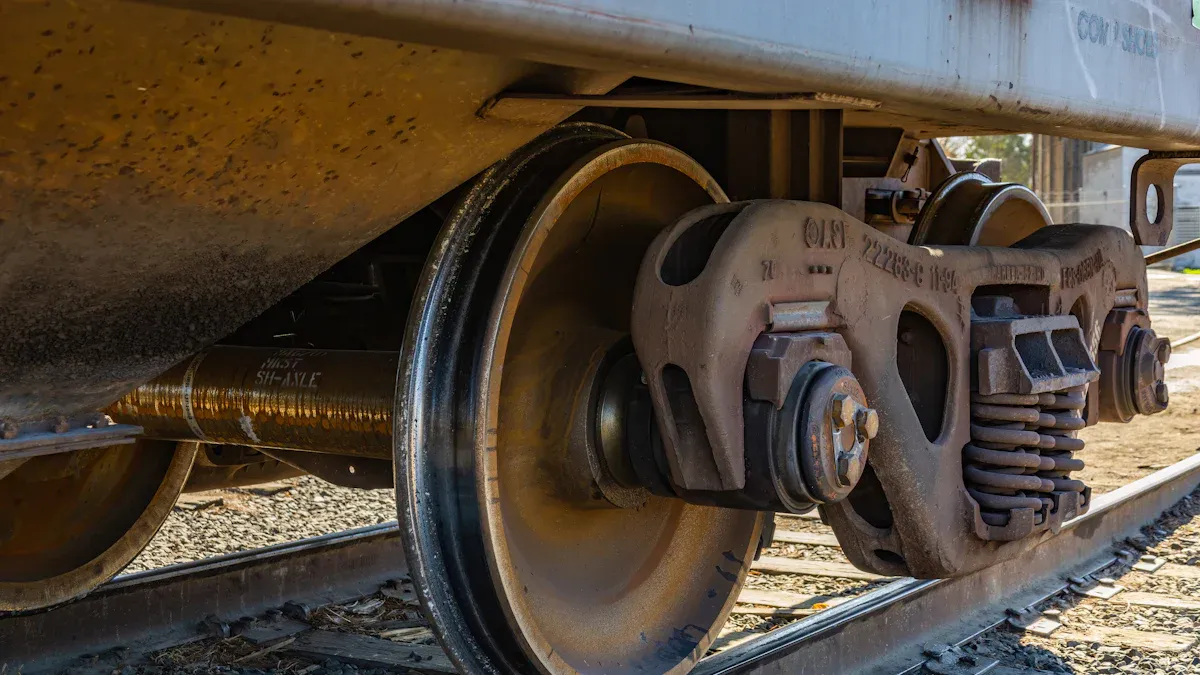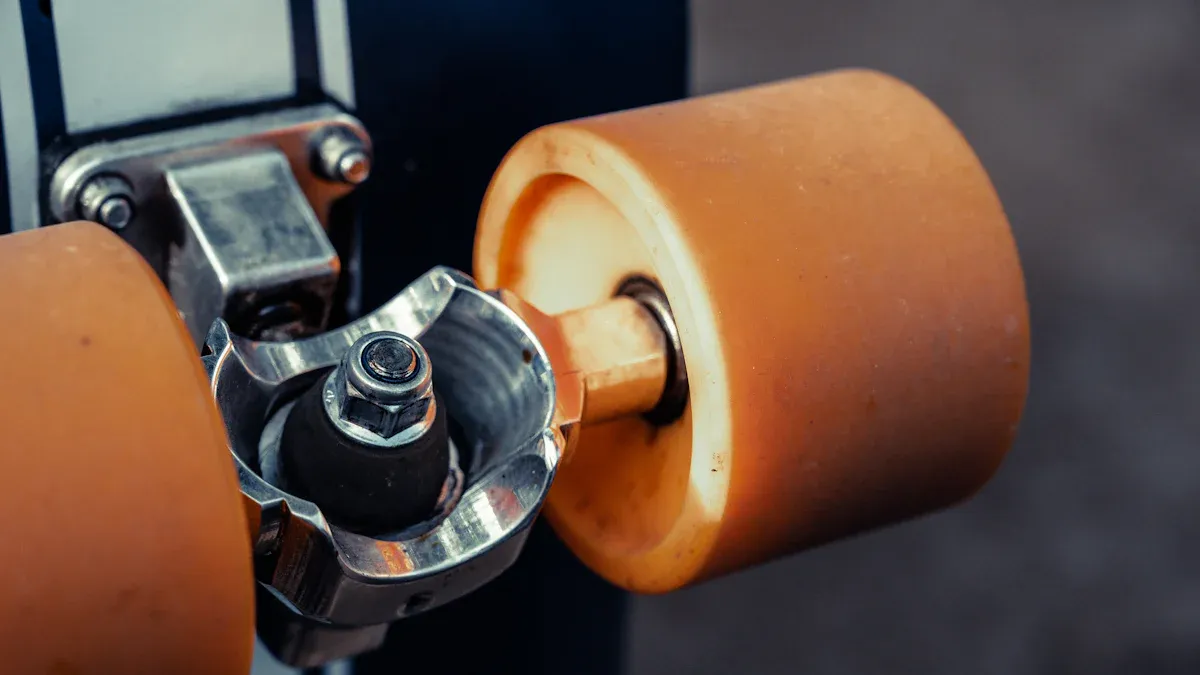
Bearings help machines move smoothly. Deep Groove bearing, Tapered Roller, Needle, and Track Roller types each have a unique design.
- Deep Groove bearing handles radial and some axial loads.
- Tapered Roller, Needle, and Track Roller bearings support different loads and speeds.
Choosing the right type improves machine life.
Key Takeaways
- Deep Groove bearings run quietly, need little maintenance, and handle both radial and some axial loads, making them ideal for electric motors and household appliances.
- Tapered Roller, Needle, and Track Roller bearings each serve specific needs: Tapered Roller handles heavy loads, Needle fits tight spaces with high radial loads, and Track Roller works well on tracks with heavy loads.
- Choosing the right bearing based on load type, space, and speed improves machine life and performance, so match the bearing to the machine’s needs for best results.
Deep Groove bearing, Tapered Roller, Needle, and Track Roller Bearings Explained

Deep Groove bearing: Definition, Structure, and Features
A Deep Groove bearing is a common type of rolling bearing. It has an inner ring, an outer ring, a cage, and balls. The deep grooves in the rings help the balls move smoothly. This design allows the Deep Groove bearing to handle both radial and some axial loads. People use this bearing because it runs quietly and needs little maintenance.
Tip: Deep Groove bearing works well in electric motors and household appliances.
Tapered Roller Bearings: Definition, Structure, and Features
Tapered Roller Bearings use rollers shaped like cones. The rollers and raceways meet at a common point. This design helps the bearing support heavy radial and axial loads. Tapered Roller Bearings often appear in car wheels and gearboxes. They last long and handle shock loads well.
Needle Roller Bearings: Definition, Structure, and Features
Needle Roller Bearings have long, thin rollers. These rollers are much longer than their diameter. The bearing can fit into tight spaces because of its slim shape. Needle Roller Bearings support high radial loads but not much axial load. Engineers use them in engines, pumps, and transmissions.
Track Roller Bearings: Definition, Structure, and Features
Track Roller Bearings have thick outer rings. They roll along tracks or rails. The design helps them carry heavy loads and resist wear. Track Roller Bearings often work in conveyor systems and cam drives.
Note: These bearings can handle both straight and curved tracks.
Comparing Bearing Types and Selection Guide

Key Differences in Structure and Function
Each bearing type has a unique structure. Deep Groove bearing uses balls that fit into deep tracks. This design lets the balls move smoothly and handle both radial and some axial loads. Tapered Roller Bearings use cone-shaped rollers. These rollers can support heavy radial and axial loads at the same time. Needle Roller Bearings have long, thin rollers. They fit into small spaces and carry high radial loads. Track Roller Bearings have thick outer rings. These rings help the bearing roll along tracks and carry heavy loads.
Note: The shape and size of the rolling elements decide how each bearing works best.
Advantages and Disadvantages of Each Bearing Type
The table below shows the main pros and cons of each bearing type:
| Bearing Type | Advantages | Disadvantages |
|---|---|---|
| Deep Groove bearing | Quiet, low maintenance, versatile | Limited axial load capacity |
| Tapered Roller | Handles heavy loads, durable | Needs careful alignment, more space |
| Needle Roller | Fits tight spaces, high radial load | Low axial load capacity, wears faster |
| Track Roller | Handles heavy, shock loads, durable | Heavier, more friction |
Typical Applications for Each Bearing
Engineers choose bearings based on the needs of the machine. Deep Groove bearing often appears in electric motors, fans, and home appliances. Tapered Roller Bearings work well in car wheels, gearboxes, and heavy machinery. Needle Roller Bearings fit inside engines, pumps, and transmissions where space is tight. Track Roller Bearings serve in conveyor systems, cam drives, and rail guides.
Tip: Always match the bearing type to the load and movement in the application.
How to Choose the Right Bearing
Selecting the right bearing helps machines last longer and work better. First, check the type of load—radial, axial, or both. Next, look at the space available for the bearing. Think about the speed and the working environment. For quiet and low-maintenance needs, Deep Groove bearing is a good choice. For heavy loads and shock, Tapered Roller or Track Roller Bearings work best. When space is limited, Needle Roller Bearings fit well.
Engineers often use charts and guides from bearing makers to help with selection.
Engineers select bearings based on load, space, and speed needs. Deep Groove bearing suits quiet, low-maintenance machines. Tapered Roller, Needle, and Track Roller bearings each fit specific jobs. Choosing the right bearing helps machines last longer and work better.
Careful selection improves equipment reliability and performance.
FAQ
What is the main difference between Deep Groove and Tapered Roller Bearings?
Deep Groove bearings use balls and handle moderate loads. Tapered Roller bearings use cone-shaped rollers and support heavier radial and axial loads.
When should engineers use Needle Roller Bearings?
Engineers choose Needle Roller Bearings for machines with limited space and high radial loads. These bearings fit well in engines and transmissions.
Can Track Roller Bearings handle curved tracks?
Yes. Track Roller Bearings work on both straight and curved tracks. Their thick outer rings help them roll smoothly and carry heavy loads.
NEW3
Post time: Jun-27-2025




